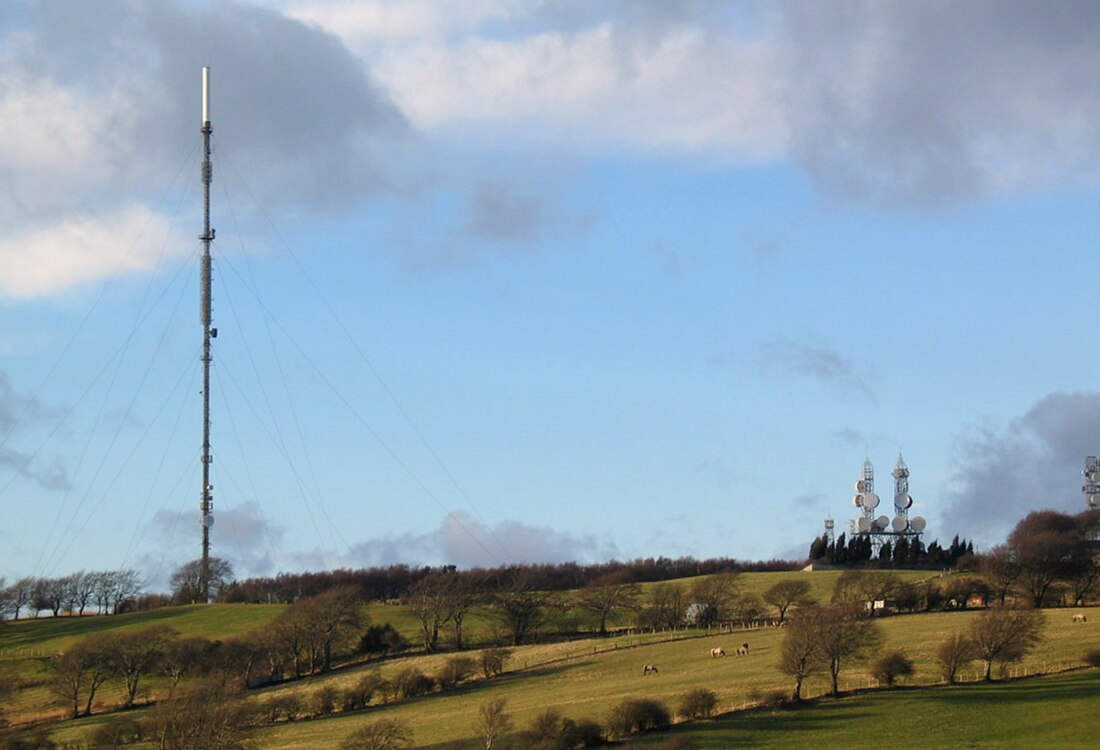Top Qs
Timeline
Chat
Perspective
Pontop Pike transmitting station
Telecommunications and broadcasting facility in England From Wikipedia, the free encyclopedia
Remove ads
The Pontop Pike transmitting station is a facility for telecommunications and broadcasting situated on a 312-metre (1,024-ft) high hill of the same name between Stanley and Consett, County Durham, near the village of Dipton, England. The mast is 149 metres (489 ft) high, giving an average antenna height of 461 metres (1,512 ft) above sea level. It is owned and operated by Arqiva.
This article has multiple issues. Please help improve it or discuss these issues on the talk page. (Learn how and when to remove these messages)
|
Remove ads
History
The mast was built in 1953, by BICC with Rowridge (also 500 feet (150 m)) and North Hessary Tor in Devon (650 feet (200 m)).
Its construction was brought forward by the BBC so that people in North East England could watch the Coronation of Queen Elizabeth II live on the 405-line television system VHF then in use in the UK. Test transmissions from a low-power temporary aerial began on Monday, 20 April 1953, and the first programmes were transmitted on Friday, 1 May 1953, in plenty of time for the Coronation on 2 June. UHF transmissions began in 1966 with the first colour transmissions in 1970, and the VHF television signal was switched off in 1985.[1]
Remove ads
Coverage
The Pontop Pike transmitter provides digital television transmissions to Tyne and Wear, County Durham, Tees Valley, most of Northumberland and parts of North Yorkshire. This includes the cities of Newcastle, Durham and Sunderland. It also carries the national BBC Radio FM signals, covering the whole North East, as well as 95.4 MHz FM BBC Newcastle. It was one of the first national FM transmitters in December 1955. All of its television output is within the C/D aerial group.
Remove ads
Digital TV switchover
Analogue TV transmissions from this mast began to close from 12 September 2012 and completely ceased on 26 September that year, making Pontop Pike, alongside Bilsdale and Chatton, the last-but-one transmitter group in the United Kingdom to complete digital switchover (DSO) with Northern Ireland being the last area to switch. In July 2007 it was confirmed by Ofcom that Pontop Pike would remain a C/D group after DSO.
Pontop Pike underwent its 700 MHz clearance between September and November 2019 when its output moved down the band from a C/D group to a K group. Thus people with original C/D group aerials, who live in poor reception areas, may struggle to pick up some channels.
Services listed by frequency
Summarize
Perspective
Analogue radio
Digital radio
Digital television
Before 700 MHz clearance
Before switchover
Analogue television
Analogue television from Pontop Pike has now ceased permanently. BBC2 analogue was switched off on 12 September 2012 and the remaining three on 26 September 2012. Pontop Pike never transmitted analogue Channel 5. Instead it was transmitted from Burnhope on UHF 68.
Remove ads
Relay services
Summarize
Perspective
Being the main broadcasting transmitter, there are also a number of relays (or repeaters) to cover patches where this transmitter can't properly serve.
Analogue radio
Digital television
The following is a list of the television relays served by Pontop Pike:
Remove ads
See also
References
External links
Wikiwand - on
Seamless Wikipedia browsing. On steroids.
Remove ads


